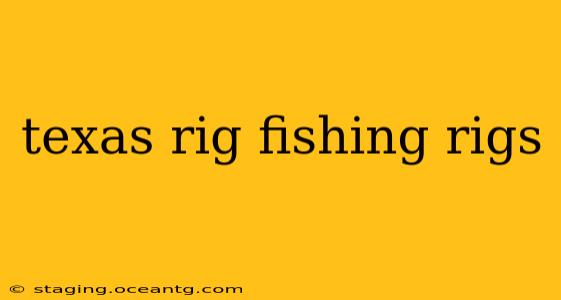The Texas rig is a staple in bass fishing, renowned for its versatility and effectiveness in a wide range of conditions. This comprehensive guide will delve into everything you need to know about Texas rigs, from the basics to advanced techniques, ensuring you're equipped to catch more fish. Whether you're a seasoned angler or just starting, understanding the nuances of this rig is key to unlocking its full potential.
What is a Texas Rig?
A Texas rig is a simple yet incredibly effective fishing setup that involves a hook, weight, and bait, all strategically assembled to create a weedless presentation. The weight is positioned above the hook, allowing the bait to move freely and naturally, while the hook is offset to minimize snags. This makes it ideal for fishing in heavy cover like weeds, grass, and wood, where other rigs might get snagged.
How to Rig a Texas Rig?
Step-by-Step Instructions:
-
Choose your hook: Offset shank hooks are crucial for a weedless presentation. The offset design allows the hook point to lay flat against the bait, reducing snags. Hook size depends on the size of your bait and the target fish.
-
Select your weight: Weight selection depends on the depth you're fishing and the current conditions. Heavier weights are needed for deeper water or stronger currents. Common weights range from 1/8 oz to 3/4 oz.
-
Insert the weight: Slide the weight onto your line.
-
Tie the hook: Tie a Palomar knot or improved clinch knot to secure the hook to your line. This is crucial for reliable hook strength and prevents line breakage.
-
Thread the bait: Carefully thread your bait onto the hook, ensuring the hook point is completely concealed. This prevents snags and maintains the bait's natural action.
What are the Advantages of Using a Texas Rig?
-
Weedless Presentation: The offset hook and weight configuration allows the bait to pass through heavy cover without snagging.
-
Natural Bait Action: The bait moves freely on the rig, mimicking a natural prey, triggering strikes.
-
Versatility: Suitable for various baits, such as soft plastics, creature baits, and lizards, making it adaptable to different fishing situations.
-
Sensitivity: The weight positioned above the hook transmits subtle bites directly to the rod, allowing for quick and effective hooksets.
What Baits Work Best with a Texas Rig?
The Texas rig is exceptionally versatile, compatible with a wide range of soft plastic baits:
-
Soft Plastic Worms: Classic choice for targeting bass, offering a lifelike swimming action.
-
Creature Baits: These are effective for triggering aggressive strikes, particularly in shallower water.
-
Craw Baits: Ideal for mimicking crawfish, a common prey for bass.
-
Lizards: These baits provide excellent bottom-contact action, perfect for fishing near cover.
What are the Different Types of Texas Rigs?
While the standard Texas rig is widely used, variations exist to cater to specific situations:
-
Texas Rig with a Bullet Weight: A standard Texas rig where the weight is a bullet weight.
-
Texas Rig with a Worm Weight: Similar to a bullet weight, but typically designed to better conceal the weight.
-
Texas Rig with a Weighted Hook: The weight is already integrated into the hook itself.
How Do I Choose the Right Weight for My Texas Rig?
The optimal weight depends on several factors:
-
Water Depth: Deeper water necessitates heavier weights to reach the bottom.
-
Current Conditions: Stronger currents require heavier weights to maintain bottom contact.
-
Bait Type: Heavier baits may require slightly heavier weights for better balance.
-
Target Fish: Different fish species and sizes may call for adjustments in weight.
What are Some Common Mistakes to Avoid When Using a Texas Rig?
-
Incorrect Hook Setting: Not setting the hook firmly can lead to missed strikes.
-
Using the Wrong Weight: Using an inappropriate weight can negatively affect bait action and presentation.
-
Poor Bait Selection: Choosing the wrong bait for the conditions can reduce your chances of success.
By mastering the art of the Texas rig, you significantly enhance your bass fishing capabilities. Remember, practice makes perfect; experiment with different weights, baits, and techniques to discover what works best in various situations. The Texas rig's versatility and effectiveness make it a valuable asset in any angler's arsenal.
